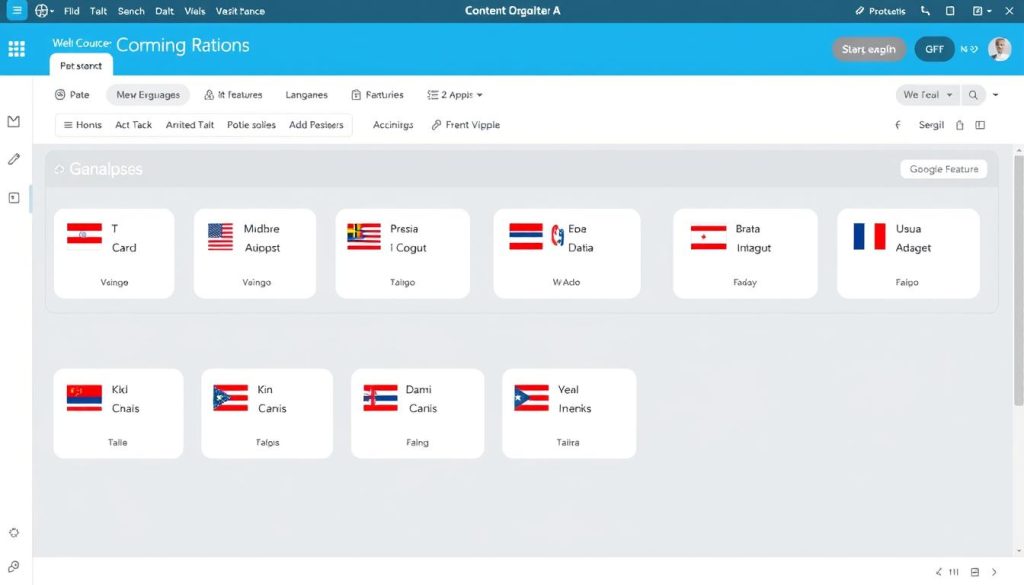In today’s global marketplace, businesses need more than generic content to resonate with local audiences.
Localized content marketing has emerged as a powerful strategy for brands to connect authentically with customers across different regions and cultures.
We help brands navigate the complex process of adapting their content to be more relevant to local audiences, considering nuances, cultural differences, and current trends in each target market.
By implementing localized content strategies, businesses can dramatically boost engagement, build trust, and drive conversions.
Key Takeaways
- Understand the importance of adapting content for local audiences.
- Learn how localized content marketing can boost engagement and drive conversions.
- Discover strategies for implementing effective localization processes.
- Explore real-world examples of successful localization efforts.
- Gain insights into refining your existing localization strategy.
What Is Localized Content Marketing?
The concept of localized content marketing revolves around creating content that resonates with local audiences, taking into account their unique cultural, linguistic, and regional nuances. This approach is crucial for businesses aiming to establish a strong presence in diverse markets.
Definition and Scope
Localization of content involves more than just translating text from one language to another. It encompasses adapting the content to fit the cultural context, preferences, and behaviors of the target audience. Effective localization ensures that the message conveyed is not only understood but also resonates emotionally with the local audience.
- Adapting content to local customs and practices.
- Using culturally relevant imagery and symbols.
- Ensuring that translation is not just linguistically accurate but also contextually relevant.
Beyond Simple Translation

While accurate translation forms the foundation of content localization, truly effective localization requires a deeper cultural adaptation process, often referred to as “transcreation.” This involves recreating the content’s intent, style, tone, and emotional impact for a new cultural context, preserving the original message’s essence while making it culturally relevant.
- Addressing cultural nuances that direct translation might miss.
- Adjusting visual elements to avoid cultural misinterpretations.
- Creating content that feels as though it was originally created for the local market.
Why Localized Content Marketing Matters
As businesses look to expand globally, localized content marketing emerges as a key strategy for success. In an increasingly interconnected world, companies must adapt their marketing approaches to resonate with diverse local audiences.
Building Trust with Local Audiences
Localized content marketing is about more than just translation; it’s about understanding the cultural nuances and preferences of your target audience. By creating content that speaks directly to local customers, you build trust and establish a stronger connection with them. This approach enables you to address specific pain points and preferences that generic content cannot match.
Key benefits of localized content include:
- Enhanced credibility with local audiences
- Increased relevance of your marketing efforts
- Better alignment with local market needs
Competitive Advantages in Global Markets
In global markets, a well-executed localization strategy can be a significant differentiator. Companies that invest in thorough localization can capture market share more quickly than those relying on generic global content. By tailoring your content to specific markets, you can outcompete larger global players and establish a strong local presence.

| Localization Aspect | Global Content Approach | Localized Content Approach |
|---|---|---|
| Cultural Relevance | Generic, one-size-fits-all | Tailored to local culture and preferences |
| Market Penetration | Slow, due to lack of local resonance | Faster, as content resonates with local audience |
| Competitive Edge | Limited, as content is not differentiated | Significant, as localized content stands out |
By adopting a localized content marketing strategy, businesses can not only expand their global reach but also establish a competitive edge in diverse markets. This approach allows companies to be more agile and responsive to local market needs, ultimately driving growth and success in an increasingly globalized economy.
Key Benefits of Implementing Localized Content Marketing
In today’s global marketplace, localized content marketing is no longer a luxury, but a necessity. By tailoring your content to local markets, you can significantly enhance your online presence and drive business growth.
Localized content marketing offers numerous benefits, including improved conversion rates, enhanced customer experience, and better SEO performance. Let’s dive into these advantages in more detail.
Increased Conversion Rates and ROI
Localized content resonates more effectively with local audiences, leading to increased conversion rates. When your content speaks to the specific needs and preferences of a region, you’re more likely to attract and retain customers. This, in turn, can lead to a higher return on investment (ROI) for your marketing efforts.
For instance, a study on localization found that companies that localized their content saw a significant increase in conversion rates compared to those that didn’t.
| Company | Localization Strategy | Conversion Rate Increase |
|---|---|---|
| Company A | Localized content and website | 25% |
| Company B | Non-localized content | 5% |
Enhanced Customer Experience
Localization is not just about translating content; it’s about creating a tailored experience for your customers. By understanding local cultures and preferences, you can develop content that resonates with your target audience, enhancing their overall experience with your brand.
“The key to successful localization is understanding the nuances of the local culture and adapting your content accordingly.”
Improved SEO Performance
Localized content significantly boosts your search engine rankings by incorporating region-specific keywords and phrases. This enhances visibility on local search engines, attracting more organic traffic and ultimately increasing your site’s reach and engagement with local audiences.

By implementing a well-planned localized content marketing strategy, you can reap these benefits and drive sustainable growth for your business. As search behavior varies dramatically across countries, segregating your SEO efforts for each target market becomes crucial.
Understanding Your Target Markets
A profound comprehension of your target markets is essential for tailoring your content marketing strategy. To achieve this, we must delve into the specifics of the regions we’re targeting, understanding not just the language, but the cultural context, preferences, and nuances that define these markets.
Conducting Effective Market Research
Effective market research is the cornerstone of understanding your target markets. This involves more than just demographic analysis; it requires a deep dive into the cultural fabric of the region. Partnering with local experts who understand the intricacies of daily life, cultural taboos, humor styles, and communication preferences can provide invaluable insights. They can help identify potential pitfalls in your localization strategy and ensure your content resonates with the local audience.
Identifying Cultural Nuances and Preferences
Cultural influences often guide decisions in subtle ways that aren’t immediately apparent. By understanding these cultural nuances, we can shape our localized marketing strategy to build natural trust with our buyers. This includes being mindful of visual elements like colors, symbols, and imagery, which can have dramatically different meanings across cultures.

To further illustrate the importance of cultural understanding, let’s examine a few key areas:
- Successful localization requires identifying both obvious and subtle cultural nuances.
- Local experts can provide critical insights into cultural taboos and communication preferences.
- Visual elements must be carefully selected to avoid cultural missteps.
| Cultural Aspect | Importance in Localization | Example |
|---|---|---|
| Language | Direct communication | Using local dialects or region-specific terminology |
| Visual Elements | Cultural sensitivity | Avoiding symbols or colors with negative connotations |
| Decision-Making Processes | Understanding cultural priorities | Recognizing whether individual or collective decision-making is preferred |
By understanding and respecting these cultural nuances and preferences, we can create a content localization strategy that not only resonates with our target audience but also fosters a deeper connection with them.
Creating a Comprehensive Localization Strategy

A well-crafted localization strategy is the backbone of any successful global marketing effort. We understand that expanding into new markets requires more than just translating content; it demands a thoughtful approach to resonate with local audiences.
Setting Clear Goals and Priorities
To develop an effective localization strategy, we start by setting clear goals and priorities. This involves understanding our target audience, identifying key markets, and determining the type of content that will resonate with them. By doing so, we can focus our efforts on the most impactful initiatives.
Selecting Content for Localization
Not all content is created equal when it comes to localization. We carefully select content that is most relevant to our target audience and has the potential to drive engagement. This may include website content, marketing materials, or product descriptions. Our goal is to ensure that the localized content is of high quality and aligns with our brand voice.
Allocating Resources and Budget
Effective localization requires appropriate resource allocation, both financial and human, to achieve quality results that drive business outcomes. We develop a realistic budget that accounts for all aspects of localization, including translation, cultural adaptation, design modifications, technical implementation, and ongoing maintenance.
Key considerations for allocating resources and budget include:
- Effective localization requires appropriate resource allocation – both financial and human – to achieve quality results that drive business outcomes.
- Develop a realistic budget that accounts for all aspects of localization including translation, cultural adaptation, design modifications, technical implementation, and ongoing maintenance.
- Consider the total cost of ownership when making build-vs-buy decisions – in-house localization teams require significant investment in talent, tools, and processes that many organizations underestimate.
- Evaluate whether to partner with specialized localization agencies, freelance experts, or build internal capabilities based on your volume, frequency, and quality requirements.
- Implement a scalable resource model that can flex with changing business needs – many organizations benefit from a hybrid approach combining internal oversight with external specialized support.
By following these guidelines and considering the complexities involved in localization, we can create a comprehensive localization strategy that drives results and supports our global marketing efforts.
Essential Elements of Localized Content Marketing
The key to unlocking global market potential lies in understanding and implementing essential elements of localized content marketing. Effective localization goes beyond mere translation, requiring a deep dive into the cultural, linguistic, and contextual nuances of target markets.
Effective localization also applies to adapting content for countries that speak the same language. For instance, the language, references, and channels used in the US and UK should be tailored to each market. Although both countries speak English, they have different spellings, slang, cultural nuances, and frames of reference.
Language and Terminology Adaptation
Adapting language and terminology is crucial for resonating with local audiences. This involves more than just translation; it requires understanding regional dialects, idioms, and cultural references. For example, English spoken in the US, UK, and Australia has different spellings, vocabulary, and expressions.
- Use local terminology and expressions to create a more personalized experience.
- Be aware of regional dialects and their implications on content.
- Consider the impact of cultural references on your messaging.
Visual Content Localization
Visual content plays a significant role in marketing, and its localization is just as important as text. Images, colors, and graphics can have different meanings in various cultures. For instance, while white is associated with purity in Western cultures, it’s associated with mourning in many Asian cultures.

Cultural Context and References
Understanding the cultural context and references of your target audience is vital. Cultural dimensions like individualism vs. collectivism, power distance, and uncertainty avoidance influence how messages are received. Adapting your content to reference local events, celebrities, and cultural touchpoints can significantly enhance its relevance and impact.
By focusing on these essential elements, businesses can create a localized content marketing strategy that resonates with diverse audiences worldwide, driving engagement and conversion.
Implementing Your Localized Content Across Channels
Once you’ve developed your localized content, the next step is to distribute it across relevant channels. This strategic deployment ensures that your message reaches your target audience effectively, enhancing your global marketing efforts.
To achieve this, we need to consider various platforms and tailor our approach to each. The key is to be where your customers are and to communicate in their language, both literally and culturally.
Website and Landing Pages
Your website is often the first point of contact for potential customers. Localizing your website and landing pages is crucial for creating a welcoming experience for global audiences. This involves not just translating the text, but also adapting visual content, currencies, and date formats to suit local preferences.
- Ensure that your website’s URL structure and navigation are optimized for different regions.
- Use local currencies and payment methods to facilitate transactions.
- Adapt your content to reflect local cultures and preferences.
Social Media Platforms
Social media is a powerful tool for engaging with your audience. To leverage it effectively, you need to localize your social media content, including posts, images, and videos. This helps in building a strong connection with your local audience.
- Use local languages and dialects in your social media posts.
- Be aware of cultural nuances and trends in different regions.
- Engage with local influencers and respond to comments in the local language.
Email Marketing and Other Touchpoints
Email marketing requires careful localization beyond just translating the copy. Consider local preferences for email frequency, length, formality, and design aesthetics. Additionally, adapt your customer journey mapping for each market, recognizing that the path to purchase may vary significantly based on local buying behaviors and preferences.
- Localize all customer touchpoints, including help documentation, support resources, chatbots, and customer service scripts.
- Consider local preferences for communication channels – some markets may prefer SMS, messaging apps, or phone support over email or web-based interactions.
- Ensure your marketing automation systems can support multiple languages and regional variations in workflows, triggers, and personalization elements.
By implementing your localized content across these channels, you can create a cohesive and effective global marketing strategy that resonates with your target audience and drives business growth.
Tools and Resources for Effective Content Localization

As businesses expand globally, the need for sophisticated tools and resources to localize content becomes increasingly important. Effective localization requires more than just translation; it demands a deep understanding of local cultures, preferences, and nuances.
Translation Management Systems
Translation Management Systems (TMS) are crucial for managing the translation process efficiently. These systems help streamline workflows, reduce costs, and improve the quality of translations by facilitating collaboration between translators, project managers, and other stakeholders.
By utilizing a TMS, businesses can automate many aspects of the translation process, ensuring consistency across all translated content.
Working with Local Experts and Translators
Working with local experts and professional translators is vital for high-quality localization. Most global brands find skilled translators through Language Service Providers (LSPs), which have a roster of certified translators and local experts for hundreds of languages.
- Professional linguists who specialize in your industry and understand your brand voice are essential for capturing nuance and maintaining impact.
- Build relationships with in-country reviewers who can validate translations for cultural appropriateness and regional relevance.
- Consider working with specialized localization agencies that offer end-to-end services.
- Develop clear briefs for your localization partners that include context, target audience information, and brand guidelines.
- Invest in educating your translation partners about your products, services, and brand positioning.
Common Challenges and How to Overcome Them
As businesses expand globally, they often encounter significant challenges in maintaining a consistent brand identity while catering to local preferences. Effective localization is crucial, but it requires careful planning and execution.
One of the primary difficulties is balancing global brand identity with local relevance. This involves adapting content to suit local cultures and preferences without diluting the brand’s overall image.
Balancing Global Brand Identity with Local Relevance
To achieve this balance, businesses must understand their target markets deeply. This includes being aware of cultural nuances, local trends, and consumer behavior. By doing so, companies can create content that resonates with local audiences while maintaining their global brand essence.
Key strategies include:
- Conducting thorough market research to understand local preferences and cultural sensitivities.
- Adapting content to meet local needs without altering the core brand message.
- Ensuring that local content is not just translated but is culturally relevant and engaging.

Managing Complex Workflows and Quality Control
Managing localization across multiple markets, content types, and teams creates complex workflows that require careful orchestration. To maintain efficiency and quality, businesses should implement a centralized localization management system.
Effective strategies for managing workflows include:
- Implementing a centralized localization management system for better visibility and accountability.
- Establishing clear quality assurance protocols, including linguistic review and cultural appropriateness assessment.
- Creating detailed documentation of localization processes to ensure consistency.
- Developing a continuous improvement approach by tracking quality issues and implementing process changes.
By addressing these challenges proactively, businesses can enhance their localization efforts, ensuring that their content is not only high-quality but also relevant and engaging for local audiences.
Conclusion: Taking Your Localized Content Marketing to the Next Level
The journey to effective localized content marketing requires ongoing commitment and a deep understanding of diverse audiences. As we refine our localization strategy, it’s crucial to measure both quantitative metrics, such as conversion rates and engagement, and qualitative feedback from local markets to continuously improve our approach.
To stay ahead, consider implementing advanced localization techniques like dynamic content personalization that adapts not just to language but to regional preferences, behaviors, and cultural contexts. Emerging technologies, such as AI-assisted translation and cultural adaptation tools, can enhance efficiency while maintaining quality.
We must view localization efforts not as a cost center but as a strategic investment that drives international growth, builds brand equity, and creates a sustainable competitive advantage in diverse markets. By doing so, we can successfully localize content and elevate our marketing efforts to achieve global success.
